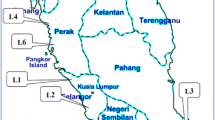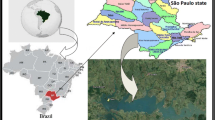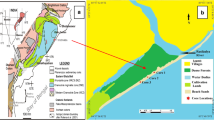Abstract
Peloids from some Cuban spas (San Diego, Elguea, Santa Lucía, Cajío and Colony) have been studied using Instrumental Neutron Activation Analysis (INAA). Concentrations of 35 major, minor and trace elements in the peloids are reported, including an important group of rare earth elements (REE). Elemental concentrations are compared with to other worldwide reported peloids, consensus based Sediment Quality Guidelines (SQG) and the concentration limits established by the U.S. Pharmacopeia. The measured REE contents are of the same order of magnitude as worldwide reported peloids. However, the behaviour of the Upper Continental Crust-normalized REE content shows different patterns and Ce- and Eu-related anomalies for peloids matured with marine and fresh waters, respectively.




Similar content being viewed by others
References
Gomes C, Carretero MI, Pozo M, Maraver F, Cantista P, Armijo F, Legido JL, Teixeira F, Rautureau M, Delgado R (2013) Peloids and pelotherapy: historical evolution. Classification and glossary. Appl Clay Sci 75–76:28–38
Gomes C (2017) Healing and edible clays: a review of basic concepts, benefits and risks. Environ Geochem Health. https://doi.org/10.1007/s10653-016-9903-4
Tateo F, Ravaglioli A, Andreoli C, Bonina F, Coiro V, Degetto S, Giaretta A, Menconi Orsini A, Puglia C, Summa V (2009) The in vitro percutaneous migration of chemical elements from a thermal mud for healing use. Appl Clay Sci 44:83–94
Carretero MI, Pozo M, Martin-Rubi JA, Pozo E, Maraver F (2010) Mobility of elements in interaction between artificial sweat and peloids used in Spanish spa. Appl Clay Sci 48(3):506–515
Suárez Muñoz M, Melián Rodríguez C, Gelen Rudnikas A, Díaz Rizo O, Martínez-Santos M, Ruiz-Romera E, Fagundo Castillo JR, Pérez-Gramatges A, Martínez-Villegas NV, Blanco Padilla D, Hernández Díaz R, González-Hernández P (2015) Physicochemical characterization, elemental speciation and hydrogeochemical modeling of river and peloid sediments used for therapeutic uses. Appl Clay Sci 104:36–47
Díaz Rizo O, Gelen Rudnikas A, D’Alessandro Rodríguez K, López Pino N, Arado López JO, González Hernández P, Melián Rodríguez CM, Suárez Muñoz M, Fagundo Castillo JR, Blanco Padilla D (2013) Assessment of historical heavy metal content in healing muds from San Diego river (Cuba) using nuclear analytical techniques. Nucleus 53:19–23
Díaz Rizo O, Suárez Muñoz M, González Hernández P, Gelen Rudnikas A, D’Alessandro Rodríguez K, Melián Rodríguez CM, Pérez Martín A, Fagundo Castillo JR, Martínez-Villegas NV (2017) Assessment of heavy metal content in peloids from some Cuban spas using X-ray fluorescence. Nucleus 61:1–5
Díaz Rizo O, Suárez Muñoz M, González Hernández P, Gelen Rudnikas A, D’Alessandro Rodríguez K, Melián Rodríguez CM, Fagundo Castillo JR, Martínez-Villegas NV (2018) Radioactivity levels in peloids used in main Cuban spas. J Radioanal Nucl Chem 316(1):95–99
Fagundo JR, Gonzalez P, Peña B, Fagundo J, Suarez M, Melián C. Origen y composición química de las aguas minerales sulfuradas de Cuba. Su relación con el medio ambiente geológico. In: Contribución a la Educación y la Protección Ambiental. Vol. 3. 2002. Electronic Book. ISBN 959-7136-13-9 (in Spanish)
Manchado A, Cervantes P (2003) InfoTER database. Version 1.0. Centro Nacional de Termalismo “Victor Santamarina” (CENTERVISA). La Habana (in Spanish)
González Hernández P (2003) Contribución al conocimiento hidroquímico de acuíferos mársicos costeros con intrusión marina. Sector Guira-Quivicán. Cuenca sur de La Habana. Ph.D. Thesis. Havana Technical University “José Antonio Hechavarría”, Havana (in Spanish)
Frontasyeva MV (2011) Neutron activation analysis for the life sciences. A review. Phys Part Nucl 42(2):332–378
Pavlov SS, Dmitriev AY, Frontasyeva MV (2016) Automation system for neutron activation analysis at the reactor IBR-2. Frank Laboratory of Neutron Physics. Joint Institute for Nuclear Research, Dubna, Russia. J Radioanal Nucl Chem 309:27–38
Müller G (1969) Index of geoaccumulation in sediments of the Rhine River. GeoJournal 2:108–118
Schropp SJ, Lewis FG, Windom HL, Ryan JD, Calder FD, Burney LC (1990) Interpretation of metal concentration in estuarine sediments of Florida using aluminum as reference element. Estuaries 13:227–235
Birch G (2003) A scheme for assessing human impacts on coastal aquatic environment using sediments. In: Wollongong CD (ed) University Papers in Center for Maritime Policy, vol 14, Australia
Wedepohl KH (1995) The composition of the continental crust. Geochim Cosmochim Acta 59(7):1217–1232
McDonald DD, Ingersoll CG, Berger TA (2000) Development and evaluation of consensus-based sediment quality guidelines for freshwater ecosystems. Arch Environ Contam Toxicol 39(1):20–31
Turekian KK, Wedepohl K (1961) Distribution of the elements in some major units of the earth’s crust. Geol Soc Am Bull 72:175–192
Da Silva PSC, Torrecilha JK, Gouvea PFM, Maduar MF, de Oliveira SMB, Scapin MA (2015) Chemical and radiological characterization of Peruíbe Black Mud. Appl Clay Sci 118:221–260
Da Silva PSC, Maduar MF, Scapin MA, García RHL, Martins JPM (2016) Radiological assessment of pharmaceuticals clays. J Radioanal Nucl Chem 307:2035–2046
Carretero MI, Pozo M, Legido JL, Fernández-González MV, Delgado R, Gómez I, Armijo F, Maraver F (2014) Assessment of three Spanish clays for their use in pelotherapy. Appl Clay Sci 99:131–143
Mascolo A, Summa V, Tateo F (1999) Characterization of toxic elements in clays for human healing use. Appl Clay Sci 15:491–500
Tateo F, Summa V, Ml Giannossi, Ferraro G (2006) Healing clays: mineralogical and geochemical constraints on the preparation of clay–water suspension (“argillic water”). Appl Clay Sci 33:181–194
Rebelo M, Viseras C, López-Galindo A, Rocha F, Ferreira da Silva E (2011) Characterization of Portuguese geological materials to be used in medical hydrology. Appl Clay Sci 51:258–266
Quintela A, Terroso D, Ferreira da Silva E, Rocha F (2012) Certification and quality criteria of peloids used for therapeutic purposes. Clay Miner 47:441–451
US Pharmacopeia 40-NF 35 (2017) US Pharmacopeia Convention, Rockville, MD
Mao L, Mo D, Yang J, Guo Y, Lv H (2014) Rare earth elements geochemistry in surface floodplain sediments from the Xiangjiang River, middle reach of Changjiang River, China. Quatern Int 336:80–88
Komar D, Rogan Šmuc N, Lambaša Belak Ž, Matešić SS, Lojen S, Kniewald G, Vrhovnik P, Dolenec T, Dolenec M (2014) Geochemical characteristics and distribution of rare earth elements in Makirina Bay sediments (N Dalmatia. Republic of Croatia). Geol Macedonica 28(2):127–137
De Baar HJW, Bacon MP, Brewer PG (1985) Rare earth elements in Pacific and Atlantic oceans. Geochim Cosmochim Acta 49:1943–1959
Jiang SY, Zhao HX, Chen YQ (2007) Trace and rare earth element geochemistry of phosphate nodules from the Lower Cambrian black shale sequence in the Mufu mountain of Nanjing, Jiangsu Province, China. Chem Geol 244:584–604
Xin H, Jiang S, Yang J, Wu H, Pi D (2016) Rare earth element geochemistry of phosphatic rocks in Neoproterozoic Ediacaran Doushantuo Formation in hushan section from the Yangtze Gorges area, South China. J Earth Sci 27:204–210
Kidder D, Krishnaswamy R, Mapes RH (2003) Elemental mobility in phosphatic shales during concretion growth and implication for provenance analysis. Chem Geol 198:335–353
Bau M, Dulski P (1996) Distribution of yttrium and rare earth elements in the Penge and Kuruman iron formations. Transvaal super group South Africa. Precambrian Res 79:37–55
Dai S, Xie P, Jia S, Ward CR, Hower JC, Yan X, French D (2017) Enrichment of U-Re-V-Cr-Se and rare earth elements in the Late Permian coals of the Moxinpo Coalfield, Chongqing, China: genetic implications from geochemical and mineralogical data. Ore Geol Rev 80:1–17
Torrecilha JK, Carvalho LP, Gouvea PFM, da Silva PSC (2015) Rare earth elements behavior in Peruibe black mud. In: International Nuclear Atlantic Conference-INAC 2015, São Paulo, Brazil, October 4–9, Associação Brasileira de Energia Nuclear – ABEN. ISBN:978-85-99141-06-9
Author information
Authors and Affiliations
Corresponding author
Rights and permissions
About this article
Cite this article
Díaz Rizo, O., Barrios Cossio, J., González Hernández, P. et al. Instrumental neutron activation analysis of peloids from main Cuban spas. J Radioanal Nucl Chem 317, 1079–1087 (2018). https://doi.org/10.1007/s10967-018-5961-7
Received:
Published:
Issue Date:
DOI: https://doi.org/10.1007/s10967-018-5961-7




